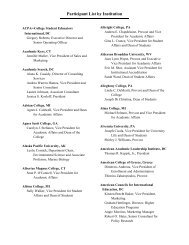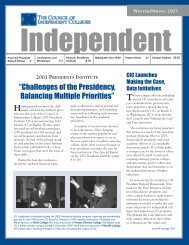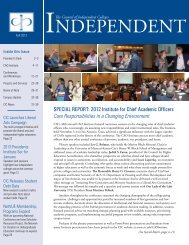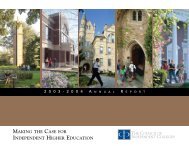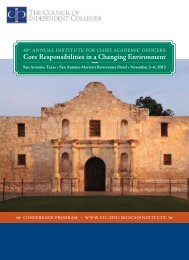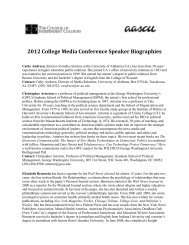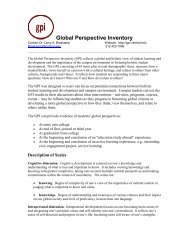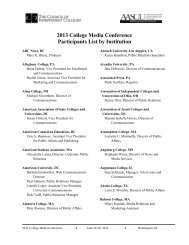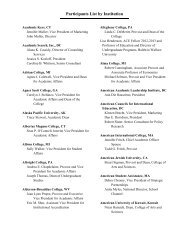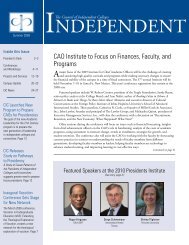Meeting the Challenge: - The Council of Independent Colleges
Meeting the Challenge: - The Council of Independent Colleges
Meeting the Challenge: - The Council of Independent Colleges
Create successful ePaper yourself
Turn your PDF publications into a flip-book with our unique Google optimized e-Paper software.
Serving Students Well: <strong>Independent</strong> <strong>Colleges</strong> Today<br />
<strong>The</strong> single most<br />
important<br />
ingredient in<br />
Dillard University’s<br />
(Louisiana)<br />
success is<br />
understanding <strong>the</strong><br />
needs <strong>of</strong> each<br />
student and<br />
addressing <strong>the</strong>m<br />
to <strong>the</strong> fullest<br />
extent possible.<br />
in <strong>the</strong> Yakima Valley, where Heritage is located, and many<br />
become teachers and community leaders. Ross says that her<br />
two decades at Heritage have transformed her entire view <strong>of</strong><br />
higher education: “I have come to realize how many places<br />
<strong>the</strong>re must be where talent exists and if <strong>the</strong> educational<br />
opportunity is provided it can be <strong>of</strong> tremendous benefit to<br />
<strong>the</strong> whole community.”<br />
While Heritage is a relative newcomer in <strong>the</strong> world <strong>of</strong><br />
small and mid-sized independent colleges, Claflin University<br />
in South Carolina and Dillard University in Louisiana both<br />
date back to 1869. <strong>The</strong>y were founded during Reconstruction<br />
to provide college educations to African-American students,<br />
and that remains <strong>the</strong>ir primary mission today.<br />
Claflin has faced struggles through its history,<br />
but is now in <strong>the</strong> midst <strong>of</strong> a renaissance. A decade ago, it<br />
enrolled students with low SAT scores and <strong>the</strong>n struggled<br />
to retain <strong>the</strong>m (<strong>the</strong> first-year retention rate was less than<br />
50 percent). Today, <strong>the</strong> first-year retention rate at Claflin is<br />
nearly 80 percent, average SAT scores are up by 250 points,<br />
and enrollment has climbed from 1,000 to 1,800. <strong>The</strong><br />
establishment <strong>of</strong> an Honors College in 1994 has played a<br />
key role in turning Claflin around. <strong>The</strong> recent creation <strong>of</strong> a<br />
Freshman College, which coordinates placement, orientation,<br />
advising, tutoring, and mentoring, has also made an<br />
important difference. Meanwhile, Claflin continues to serve<br />
large numbers <strong>of</strong> students from low-income families, with<br />
about 70 percent <strong>of</strong> <strong>the</strong> current undergraduates coming from<br />
families with annual incomes <strong>of</strong> less than $25,000.<br />
<strong>The</strong> university’s focus on its primary mission remains as<br />
strong as ever.<br />
Until <strong>the</strong> recent devastation by Hurricane Katrina,<br />
Dillard University in Louisiana was also rising after a period<br />
<strong>of</strong> financial uncertainty—and <strong>the</strong> institution’s leaders are<br />
optimistic that Dillard will continue to thrive when <strong>the</strong><br />
university re-opens in 2006. Members <strong>of</strong> <strong>the</strong> university<br />
community are “on a mission to return Dillard to <strong>the</strong><br />
superior learning institution it was before <strong>the</strong> hurricane,”<br />
says president Marvalene Hughes. <strong>The</strong>y want “teaching<br />
56



